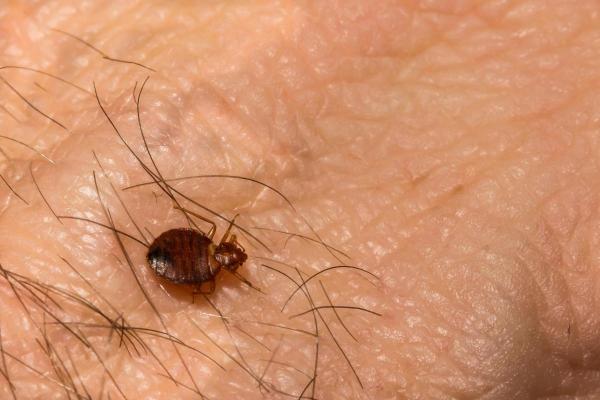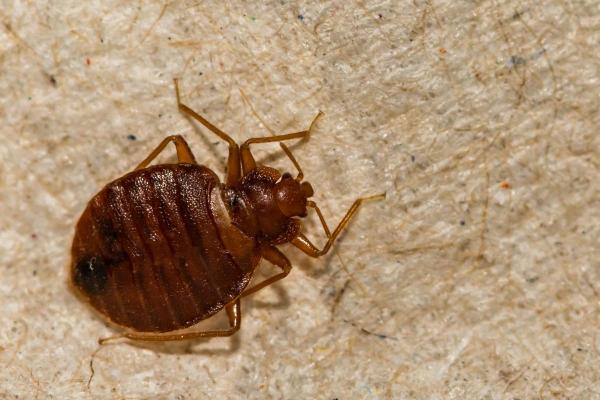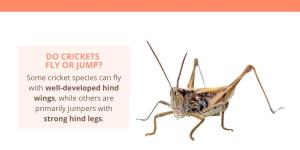Do Bed Bugs Fly or Jump?


Bed bugs don't fly since they do not have wings or any other appendages for flight. They are also not very good jumpers, something which might be confusing due to their reputation for infestation. Since bed bugs are notorious for being spread among humans and infesting beds, we might think this is due to their ability to jump or fly easily. With an almost worldwide distribution, these insects from the genus Cimex are increasing in populations in certain places, despite previous decline. This resurgence of bed bug infestations is worrying for many of us since they can bite us where we sleep. Knowing how they travel helps us to know how to stop them traveling to our own bed.
At AnimalWised, we investigate by asking do bed bugs fly or jump? We look at bed bug mobility so we can understand how they do get around and what we can do to prevent them infesting our home.
What are bed bugs?
While there are other insects that can infest a bed, those we know as bed bugs are specifically those of the genus Cimex. The two most common members of this genus are the common bed bug (Cimex lectularius) and the tropical bed bug (Cimex hemipterus). Despite the latter's name, it is now known to have a wider distribution in more temperate climates as well.
Bed bugs are obligate hematophagous ectoparasites. This means they are external parasites that feed on blood. They do so by climbing on the surface of their host and biting with their mouth parts. These biting bed bugs are generally light brown in color, although they can also have a reddish hue. The body is flattened and oval in shape. It has a pair of vestigial front wings, which have been considerably reduced, making them non-functional.
When they are adults, bed bugs grow between 4 to 5 mm in length with a width that can be around 2 mm. In their reproductive cycle, they go through several nymphal stages until they finally reach adulthood. They always require blood to develop. Without blood, they will be unable to move from one stage to another.
Among the common characteristics of bed bugs, we can mention that they emit an unpleasant odor when they are squashed. This is typical of their group. It is thanks to the presence of scent glands. In order to feed only on blood, they have certain adaptations. This includes a mouthpiece that pierces the skin and injects anticoagulants through saliva. These anticoagulants allow the blood to flow for them to suck it up.
This need to bite and suck blood causes them to search out a host. While not all bed bugs will infest the same types of animal, common bed bugs can infest both humans and many common companion animals. This begs the question of whether they are dangerous to humans or their pets.
Bed bug bites can cause swelling, redness and itching. People with a greater sensitivity will have more acute symptoms. Fortunately, bed bugs are not known to transmit serious diseases such as those which are transmitted by fleas or ticks.
Take a look at our sister site to discover more about the different types of hematophagous animals which feed on blood.
Do bed bugsjump?
Some people think that bed bugs can jump high, usually because beds are most often off the ground. This is not the case. Unlike insects with a great ability to jump such as fleas, bed bugs do not have legs which can launch them high into the air. Despite an inability to jump well, bed bugs are notorious for being able to get around.
Bed bugs are mainly nocturnal animals, being most active at night. During the day, they tend to hide, although this is not an impediment to moving or searching for food during daylight hours. They are experts at taking refuge and commonly do so in the following places in the home:
- Clothes
- Footwear
- Furniture
- Suitcases
- Any object that provides adequate shelter
These tiny insects are attracted to both the carbon dioxide we emit and our warmer body temperature. They use these traits to detect us and climb up to the body to feed. When they have to feed, they leave their shelters and move to the body of a person. These people are generally lying in bed or sitting on other furniture. They access the person by walking since they cannot fly or jump, but they do so very well and relatively fast.
This aptitude to move great distances without the ability to jump means they are even able to move between different cities and even countries. When the conditions are favorable, they will reproduce abundantly. It is important to note that hygiene is not considered a significant factor in bed bug infestations, so even an other wise clean bed can become home to them.
Learn more about these types of ectoparasites with our article on the differences between fleas, ticks and bed bugs.
Do bed bugs fly?
Both the common bed bug and the tropical bed bug are the main species found in cities, and they feed almost exclusively on human blood. These species of bugs cannot fly because they do not have functional wings that allow them the ability of flight. They do have vestigial wings, adding to the common misconception that bed bugs can fly. Despite this inability to fly or jump, bed bug mobility is surprisingly fast.
It is very common for bed bugs to stay in places where people sleep or sit, so they are located in houses or apartments, cinemas, cruise ships, hotels, trains and buses. These are places where they can hide between the folds of furniture, beds, old wallpaper, carpets, sheets and even cracks. When they must feed, they crawl to their host, which is usually people.
The reasons for this increase in movement is often related to the increase in human traffic in certain areas. An example is tourist areas. The movement of luggage, higher temperatures and resistance to insecticides, are the main causes that have allowed the return of bed bug infestations in certain cities. Their very small size means they are not easy to detect, until people begin to show red marks or inflammation resulting from the bites.
How do bed bugs spread?
Bed bugs are incredibly adept at getting around, despite their inability to fly or jump. Their mobility is one of the main factors in their infestation of beds and other furniture in the home. This is due to the following factors in bed bug mobility:
- Crawling: bed bugs are agile crawlers. They have six legs that are well-suited for moving across various surfaces. They can crawl on bedding, clothing, floors, walls and even ceilings. Their legs have tiny claws at the end, helping them grip surfaces tightly.
- Hitchhiking: one of the primary reasons for bed bug infestations is their ability to hitchhike. They can easily crawl into luggage, clothing or bags, and inadvertently travel with humans from one location to another. This makes them effective stowaways, which is why they can spread quickly.
- Scent detection: bed bugs are attracted to carbon dioxide and body heat, which helps them locate potential hosts. They use their antennae to detect these cues, allowing them to find a blood meal when hosts are at rest.
- Hidden behavior: bed bugs are experts at hiding during the day. They seek out dark crevices, cracks and hiding spots in and around beds, furniture and walls. This behavior makes them less likely to be seen while they are not actively feeding.
- Aggregation pheromones: bed bugs release aggregation pheromones to communicate with other bed bugs. These chemicals attract others to gather in one location, which can lead to larger infestations.
Despite their lack of flying or jumping abilities, bed bugs are still highly successful pests due to their mobility, hitchhiking tendencies and ability to adapt to various environments. Preventing and treating bed bug infestations typically involve thorough cleaning, using specialized treatments and vigilance to stop their spread.

How to prevent bed bugs infesting the home
As we have seen, bed bug mobility is great, despite their inability to fly or jump. Preventing bed bug infestations and keeping your home bed bug-free involves a combination of vigilance and taking proactive measures. Here are some steps you can take:
- Inspect secondhand furniture: before bringing used furniture or mattresses into your home, thoroughly inspect them for signs of bed bugs. Pay close attention to seams, crevices and any cracks.
- Regularly wash and dry bedding: bed bugs can be eliminated by washing bedding and linens in hot water (at least 50 ºC/120 ºF and drying them on high heat. Regularly wash and dry curtains, blankets and other items in your home that may harbor bed bugs.
- Use mattress and box spring encasements: encasing your mattress and box spring in bed bug-proof covers can help prevent bed bugs from infesting these areas.
- Reduce clutter: while hygiene isn't a barrier for bed bugs, reducing clutter in your home gives bed bugs fewer hiding places. Keep your living space neat and organized.
- Be cautious when traveling: when staying in hotels or using public transportation, inspect your surroundings for any signs of bed bugs. Keep luggage elevated off the floor and away from the bed.
- Seal entry points: inspect your home for potential entry points, like cracks and crevices. Seal them to prevent bed bugs from coming in.
- Avoid bringing used items inside: be cautious about bringing used items, especially soft furnishings, into your home.
- Regularly vacuum and clean: frequent vacuuming can help remove any potential bed bugs or their eggs. Pay particular attention to crevices, seams and other hiding spots.
- Education: learn how to identify signs of bed bugs, such as small reddish-brown bugs, small white eggs and tiny dark fecal spots. Early detection is key to preventing infestations from spreading.
- Consult a professional: if you suspect a bed bug infestation, contact a pest control professional. They can provide a comprehensive inspection and treatment plan to eliminate the problem.
Remember that bed bug infestations can happen even in clean homes, so vigilance and prevention are essential to keep these pests at bay. Learn more about how bed bugs spread with our article on can dogs carry bed bugs?
If you want to read similar articles to Do Bed Bugs Fly or Jump?, we recommend you visit our Facts about the animal kingdom category.
- California Department of Public Health. (2022). What are bed bugs? Retrieved from: https://www.cdph.ca.gov/Programs/CID/DCDC/Pages/Chinches.aspx
- Fargo, D. (2003). Cimex hemipterus. Animal Diversity Web. Retrieved from: https://animaldiversity.org/accounts/Cimex_hemipterus/
- NatGeo Spain. (2023). Chiches, more present than ever in Europe. Retrieved from: https://www.nationalgeographic.com.es/mundo-animal/chinches-mas-presentes-que-nunca-europa_20799






